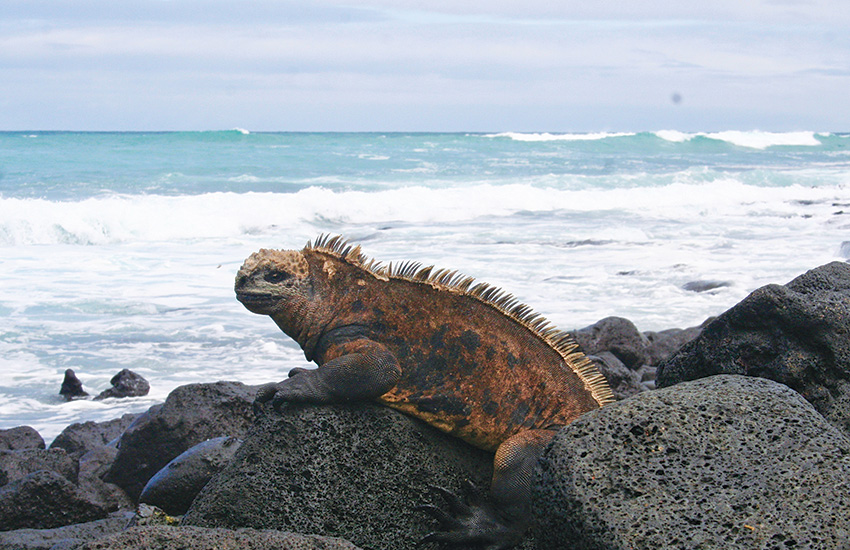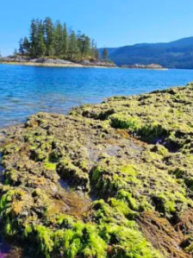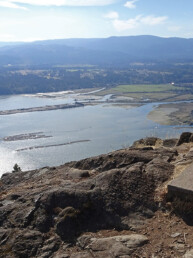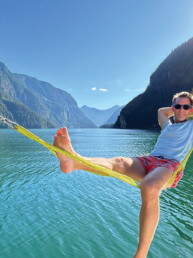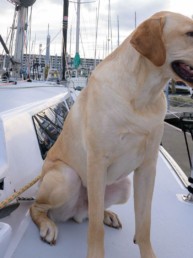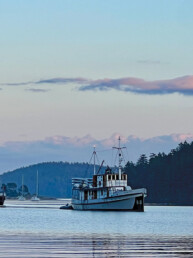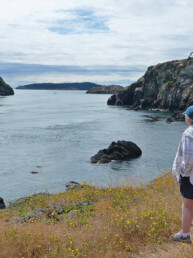This article, by Michele Rogalin Henderson, was originally published in the September 2017 issue of 48° North.
When I was a child of eight years, I knew, in the earnest way that children do, that I was meant to be a marine herpetologist when I grew up. Jacques Cousteau was my hero and I had clear visions of sailing aboard the Calypso to work alongside him studying marine iguanas in the Galápagos Islands. My father gave me a copy of Cousteau’s book, Silent World, and took me SCUBA diving for the first time when I was ten. I was entranced. Around this time, he also introduced me to sailing aboard his Irwin 10.4, the Big Sis. I loved feeling part of the water and breeze. These experiences greatly influenced the course of my life.
Fast forward 40 years, several degrees unrelated to marine herpetology, two incredible daughters launched into the world, and a lifetime of wonderful experiences later. When my love, Noj, gave me the charts and a homemade courtesy flag for the Galápagos for our first Valentine’s day together, I knew I would marry him. We set sail for the Galápagos Islands from Seattle, WA, aboard Ardea, our Beneteau Idylle 13.50. We took the scenic route via British Columbia, Canada, southeast Alaska, Mexico, and Central America. We picked up Seattle sailor, Brian Larson, in Costa Rica, and he joined us for the first two weeks in the Galápagos.
Our passage to San Cristobal island from Golfito, Costa Rica was not without incident. Our first two days and several degrees of latitude at sea were an exercise in dodging thunderstorms in what is known to meteorologists as the “monsoon trough.” Once we dropped below latitude 3, the thunderstorms abated. At latitude 2 we had a day of very rough seas during which I was tossed into the cockpit, breaking some bones in my foot and cracking a rib. The next day, just as we crossed into latitude 1, our windvane failed, with 230 nautical miles to go. Clearly, this is a complicated bit of water. The Humboldt and Panama ocean currents, along with the Equatorial counter-current, collide with interesting results. This also meant a lot of current on the nose. On the bright side, we enjoyed great breeze for most of the passage, much pomp and circumstance when crossing the Equator, and we called, “Land ho!” as we spotted the Galápagos Islands in the distance. We arrived in just under six days. Noj gets a special shout out for taking care of the final bottom scrub in cold confused seas (an immaculate hull is a requirement for the Galápagos, so as to avoid introducing invasive species).
The approach to San Cristobal is outlined clearly on the charts and we anchored among the other sailboats and tour boats. The Galápagos sea lions discovered us shortly thereafter, and came to play daily during our stay. Wiggly excited, we awaited our agent to begin the check-in process. The rules and regulations for sailing in the Galápagos are many, and the consequences for breaking them severe. We worked with an agent to guide us through the process, and were pleased to glide through with no issues (save for a bag of chia seeds, which were confiscated with flair). Free to roam, we took a water taxi to shore.
Our first stop was the island’s interpretive center. We learned about the history of the Galápagos islands, as well as the flora and fauna that have long intrigued scientists and naturalists. The next day we visited Loberia beach, where we found the first marine iguanas. My head nearly exploded, I was so excited! A lifetime dream realized, I observed them in their natural habitat on land, and snorkeled out into the sea with them to confirm the contents of many a grade-school report on the reptiles. Thankfully, Noj was right alongside me, his curiosity matching mine, as we explored San Cristobal. We trekked out to a tortoise sanctuary and learned about the supreme effort that is going into saving the various endemic species (they only exist here) of tortoises that inhabit the Galápagos. Their success in this endeavor is impressive and admirable in its scope. We enjoyed our first SCUBA adventure at Kicker Rock and were treated to sharks, rays, sea turtles, and a variety of endemic fish. Eager to contribute in some scientific way, I counted sharks for the Galápagos Conservancy and reported after each dive throughout the islands.
We motor-sailed from San Cristobal to Puerto Ayora on Santa Cruz island, not for lack of breeze, but we needed to make water and our desalinator is motor-driven. The approach to the bay is straightforward and well marked, and we anchored inside of a rocky reef near the main pier. A water taxi showed up immediately and offered to help set our stern anchor, which is standard because of the proximity of other boats and a bit of swell.
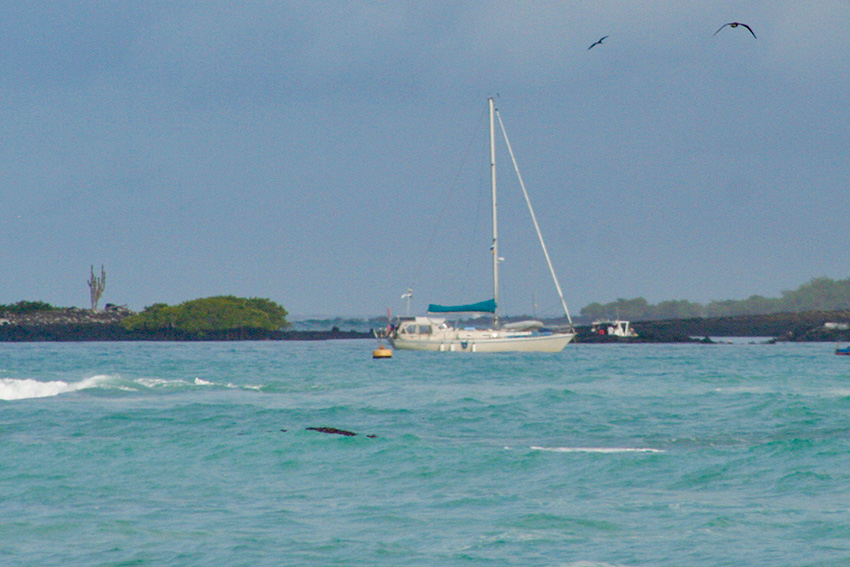
This is the largest port in the Galápagos, and, as such, a hub of activity. We visited the Charles Darwin Research Center straight away. The center is dedicated to continued research and preservation of the Galápagos’ endemic flora and fauna. We returned to Ardea to find a group of black tipped sharks parading around the boat. They remained for the duration of our stay there. We turned on the sealight and enjoyed the “shark show” every evening. Santa Cruz offers a plethora of adventures, and we availed ourselves of many of these, exploring, observing, and learning. Between lava tubes, sink holes, long treks out to gorgeous beaches, and tramping around tortoise country, I spent a lot of time hobble-hiking and wobble-walking the volcanic landscape. (My poor broken foot did not get a lot of rest.) There are mangroves and little beaches along the the shore of the port, which gave us plenty of opportunity to supervise the activities of the marine iguanas.
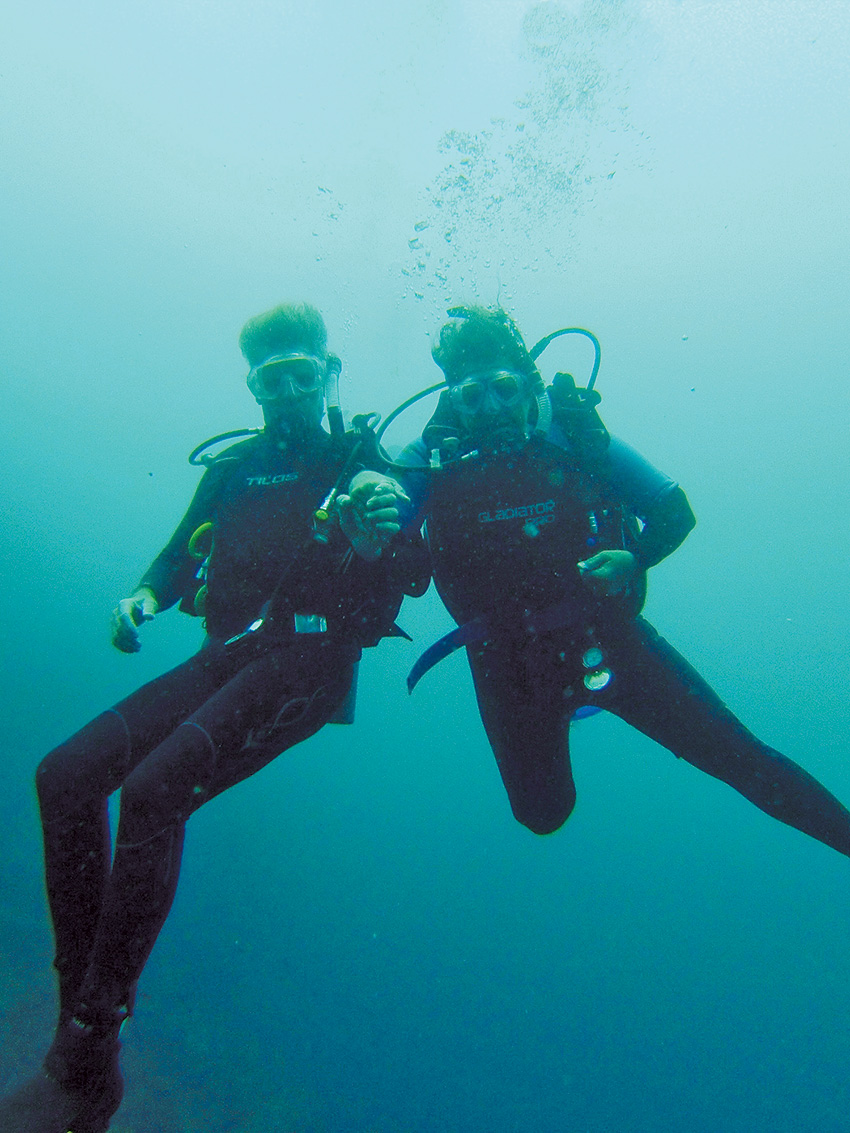
We did several amazing dive trips to surrounding islands. On our wedding anniversary, we dove at Gordon Rocks and found ourselves in the midst of thirty Hammerhead sharks. They are massive, and quite beautiful. With the Humboldt current running through the islands, the water is quite chilly (around 20° C as opposed to 30° C in Central America), and wetsuits are mandatory. I would be remiss if I failed to mention Chocolapagos, a ‘bean to turtle’ chocolate shop in town that makes fine tortoise-shaped treats. This was one of our stops during what will surely be one of the best anniversaries ever to be celebrated.
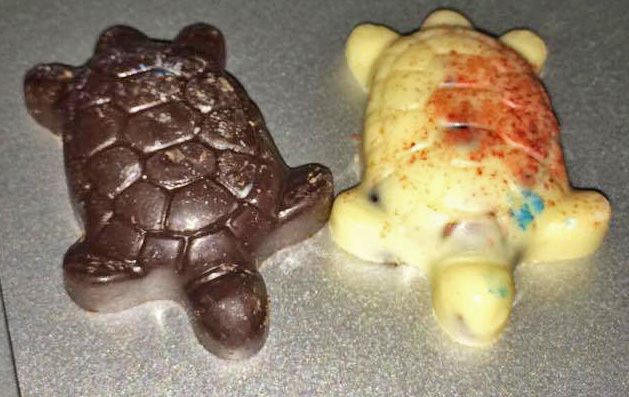
From Isla Santa Cruz we sailed to Isla Isabela in rough seas. The approach to Puerto Villamil, when the seas are anything but calm, is a bit daunting. I had the helm, as Noj was off shift taking a nap. While there are range markers and a charted approach, it looked too gnarly to go that far over in the bay, so I opted for a closer route, avoiding the reefs and crashing waves. There was definitely some sporty surfing on the way in, and we anchored behind the Tintoreros, a small group of islands that protect the harbor. We set a stern anchor here as well, due to the big swell.
We explored the islets of Tintoreros the first day, and were treated to penguins, sharks, blue-footed boobies, baby sea lions, and of course, hundreds of marine iguanas. We later snorkeled the nearby Concha Perla, and met Nixon and Mario, a couple of local guys we hung out with who told us about interesting places to explore. We fully enjoyed the laid back pace at Isabela. Our favorite hangout was Casa Rosada, a beach bar with bean bags and hammocks, where we could laze about for a couple of hours and watch the marine iguanas return from the sea to lounge with us. A snorkel trip out to the Tunnels, walks through the mangrove estuary to see the flamingos and other cool birds, and a biking adventure along the coast rounded out the visit. The turtle breeding sanctuary here was impressive as well. It is amazing how many distinct species of tortoises we met on this journey!
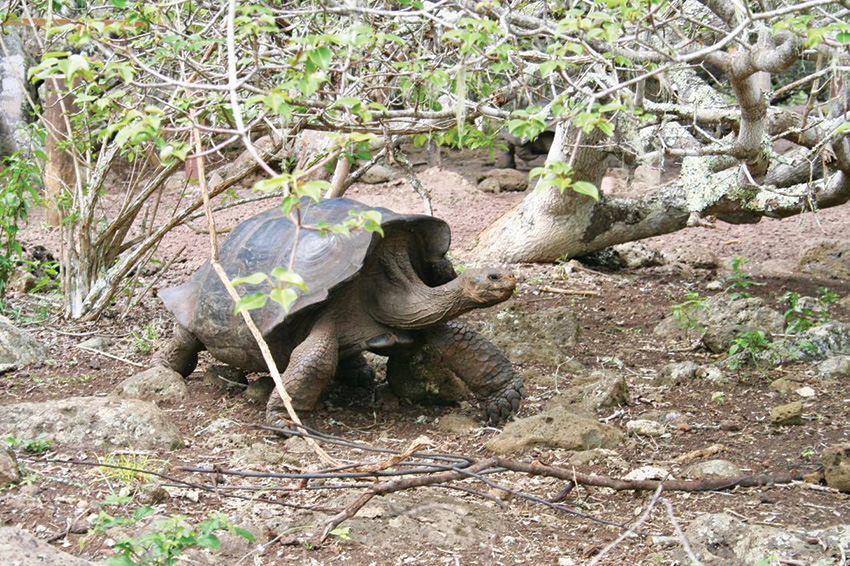
We reluctantly departed Isla Isabela for Isla Floreana, the southernmost island in the Galápagos. As we were leaving the anchorage we saw something odd in the water. It turned out to be the fins of a 4.5 meter tiger shark. With that bit of excitement, along with some glorious sunshine, we set out. The approach to Floreana is easy, and we anchored near the pier. Floreana is wonderful. There are fewer than 200 residents, and it is muy tranquilo. We were greeted by pink marine iguanas and wee baby sea lions. The port captain was super and gave us some special Floreana oranges as a welcome gift. Our first walkabout was really lovely, and profoundly quiet, save for the wildlife. We found great hikes and places to snorkel that didn’t require a guide, logged a few dives off of Ardea, and took a bus up to the highlands for a hike through a tortoise reserve, an incredible volcanic labyrinth, and some pirate caves. We were able to observe the marine iguanas foraging underwater, and confirmed why the species on Floreana is pink (it’s what they eat), as well as participated in some shark research being conducted by a visiting PhD student. The people that live here are kind and generous, as seems to be the way in very small communities. We were gifted with fruit many times, and even were given lobsters! This island quickly became our favorite.
We did not see many other sailboats in the Galápagos. Despite this, we found that most of the people visiting the Galápagos were ‘our people.’ We met outdoorsy, curious, smart, environmentally conscious travelers in all of the areas we explored. We made some friends that we know we will see again, sort of like the cruisers we have met while voyaging. The core of our mission statement is about low-impact voyaging and respect for nature and we were well pleased to find the Galápagos in total alignment. There is a deep respect for the flora and fauna, not just with the Parque Nacional personnel, but with the all of the people who live here as well. Solar and wind supply much of the energy needs, and not since the Pacific Northwest have we found a place so dedicated to separating, reusing, and recycling trash. We typically do beach cleanups everywhere we go, and were pleasantly surprised to find very little trash on the beaches. The Ecuadorian government’s efforts to preserve the unique ecosystem of the Galápagos greatly restrict private sailboats’ freedom to roam at will. We sailed to the four islands we were permitted to visit and were able to explore another three islands with guides. While we wish we could have sailed to all of the islands, we respect and appreciate the reasons we could not do so.

The experience of sailing to and in the Galápagos Islands, and fulfilling a childhood dream, has been beyond incredible. Noj and I agree, we wouldn’t do anything differently. The Galápagos islands are truly marvelous, each magnificent in its own way, and ought to be on any cruiser’s bucket list. Not a day went by that we didn’t see a new endemic bird, fish, animal, or plant that we had never seen before. We enjoyed nice breeze and relatively calm anchorages, and even the bureaucratic interactions were pleasant. The opportunity to observe marine iguanas in their natural habitat was priceless, and well worth all of the navigational challenges, storms, and regulatory challenges. It was simply amazing!
Noj & Michele just arrived safely in New Zealand. She already has a boat to race on, and they’re trying to pick a yacht club from the many options.
Follow them at www.callalooblue.com
Joe Cline
Joe Cline has been the Managing Editor of 48° North since 2014. From his career to his volunteer leadership in the marine industry, from racing sailboats large and small to his discovery of Pacific Northwest cruising —Joe is as sail-smitten as they come. Joe and his wife, Kaylin, have welcomed a couple of beautiful kiddos in the last few years, and he is enjoying fatherhood while still finding time to make a little music and even occasionally go sailing.

